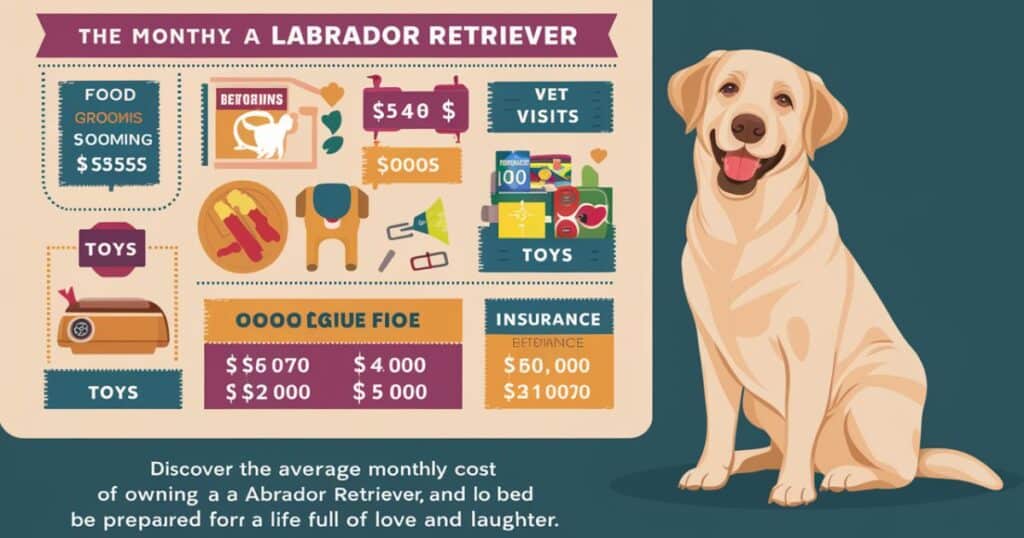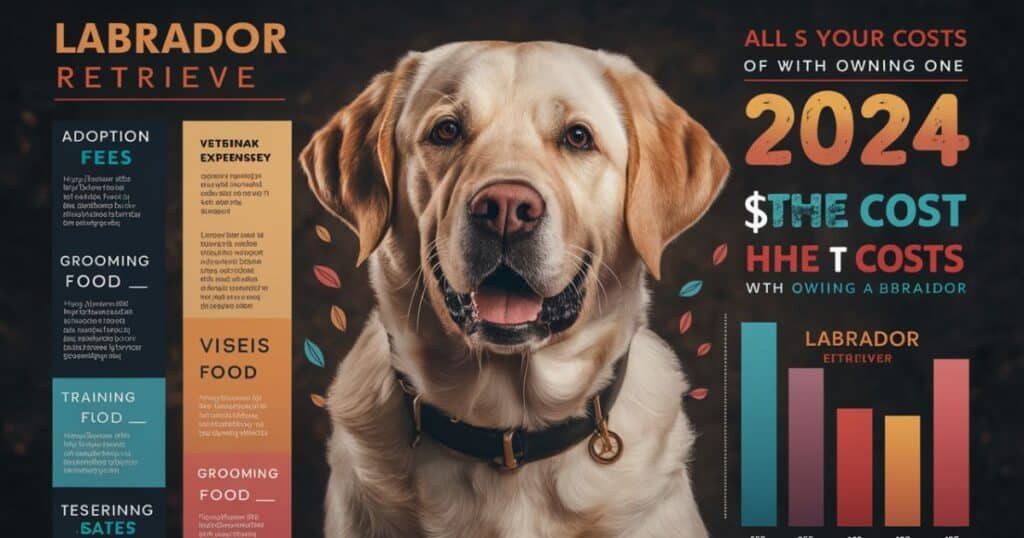Looking to add a furry, four-legged friend to your family? The Labrador Retriever is an excellent choice! These friendly, versatile dogs make wonderful companions. However, before bringing home your new Lab puppy, it’s crucial to understand the financial commitment of owning this popular breed. From upfront costs to recurring expenses, we’ll break down every monetary aspect so you can budget accordingly. Let’s dive into the price of owning a Labrador Retriever in 2024!
What is the Average Price of a Labrador Retriever Puppy?
Purebred Labrador Retriever Cost: $1,000 – $2,000
The purchase price for a purebred Labrador Retriever puppy can vary quite a bit depending on several factors. From a reputable breeder, you can expect to pay anywhere from $1,000 to $2,000 on average.
Why such a wide range? Pedigree and breeding lineage play a significant role. Puppies descended from championship bloodlines with an extensive history of conformation titles and health certifications will be on the higher end. These “show quality” puppies come with a heftier price tag.
On the other hand, Labradors bred as working dogs or from more modest pedigrees will be on the lower end of the cost spectrum, though still from responsible breeders following ethical practices.
In addition to the base price, most breeders will require:
- Deposit: Typically $200-$500 to reserve your puppy
- Sale Contract: Formalizing health guarantees, breeding rights, etc.
Be wary of any suspiciously low prices for Labrador puppies, as this could indicate a puppy mill or irresponsible breeding practices. Your best bet is to purchase from a responsible breeder who prioritizes the breed’s health and temperament over profit.
ALSO READ: THE TAN LABRADOR RETRIEVER: A COMPREHENSIVE GUIDE
Bringing Home Your New Labrador Retriever Puppy: One-Time Expenses

In addition to the cost of your new puppy, you’ll need to account for some essential one-time purchases before you can bring them home.
Here’s a breakdown of those initial expenses:
Initial Supplies: $400 – $500
Your puppy will need some basic supplies to get settled in their new home. Anticipate spending $400-$500 on these items:
- Crate & Crate Pad
- Food & Water Bowls
- Collar & Leash
- Puppy Toys
- Grooming Supplies (Brush, Shampoo, etc.)
- Puppy Pads
- Baby Gates
You may be able to find gently used items or take advantage of pet supply bundles to reduce costs in this category.
Microchipping: $50 – $70
Microchipping is highly recommended to increase the chances of reuniting with your pup if they ever get lost or stolen. Most veterinarians and animal shelters offer this simple procedure for $50-$70.
A rice grain-sized microchip is injected under your dog’s skin, allowing them to be identified and your contact information retrieved from a national registry should they go missing. Well worth the affordable one-time fee.
Puppy Vaccinations: $280 – $300
Your Labrador puppy will require a full round of core puppy vaccinations like:
- Distemper
- Parvovirus
- Rabies
- Others based on risk and vet recommendations
Administered over several appointments around 8-16 weeks old, these essential vaccinations typically cost $280-$300 from your local veterinary clinic. This ensures your new pup is protected against dangerous, potentially fatal diseases from the start.
Miscellaneous: $300 – $350
A few other costs to keep in mind when budgeting for your Labrador puppy:
- Puppy Obedience Classes: $150-$200 for a basic group class
- Training Crate: $50-$100 for a sturdy plastic or wire crate
- Professional Training (Optional): $500-$1200+ for private lessons
While not necessarily required, puppy obedience classes and crate training are very useful for Labs and worth the investment. Professional training can also be worthwhile, especially for first-time dog owners.
The Lifetime Cost of Owning a Labrador Retriever
The upfront costs of acquiring your Lab puppy are just the start – it’s also important to factor in the recurring expenses you’ll encounter over the course of your dog’s lifetime, which can be 10-12 years on average. These lifetime costs really add up, so you’ll want to budget accordingly.
List of Recurring Labrador Retriever Supplies and Costs
Let’s review some of the main recurring costs of owning a Labrador Retriever, which you’ll need to account for in your monthly budget:
| Recurring Expense | Estimated Yearly Cost |
| High-Quality Dog Food | $840 – $960 |
| Treats | $100 – $150 |
| Toys | $50 – $100 |
| Bedding | $50 – $100 |
| Grooming Supplies | $80 – $100 |
| Flea/Tick/Heartworm Prevention | $200 – $300 |
| Total | $1,320 – $1,710 |
As this handy table illustrates, the recurring costs for supplies, preventative care, and miscellaneous expenses can really add up to $1,500 or more per year. And we haven’t even touched on other major costs yet like healthcare and pet insurance!
How Much Does a Labrador Retriever Cost Per Month?

Food Costs: $70 – $80 per month
Due to their medium-to-large size, Labradors have fairly substantial dietary needs. Plan to spend around $70-$80 per month on a high-quality dog food that provides complete and balanced nutrition.
For large breed puppies, you’ll need to feed 3-4 cups of food per day spread across multiple meals. Adult Labs will consume 2-3 cups daily. High-protein, whole food ingredients are best to meet their energy requirements.
Opt for trusted brands that meet AAFCO guidelines like:
- Purina Pro Plan
- Hill’s Science Diet
- Blue Buffalo
- Iams
While tempting to choose the cheapest option, low-quality dog foods can lead to health issues and higher vet bills down the road. It’s worth investing in your Lab’s nutrition from trusted pet food manufacturers.
Grooming Costs: $50 – $60 per month
Despite their short, dense coat, Labradors do require some grooming. Professional grooming services are recommended every 8-12 weeks at a cost of around $50-$60 to keep their coat in top shape. This includes:
- Bathing and Brushing
- Nail Trimming
- Ear Cleaning
- Gland Expression
You’ll also need to budget for basic grooming supplies like deshedding tools, nail grinders, ear cleaners, etc. which can cost $50-$100 annually.
Healthcare Costs: $700 – $1,200 per year
One of the biggest recurring expenses for Labrador Retrievers is healthcare and veterinary costs. Even with a generally healthy breed, you should budget $700-$1,200 per year for:
- Annual Wellness Exams: $100-$300
- Vaccines: $80-$150
- Flea/Tick/Heartworm Prevention: $200-$300
- Routine Bloodwork: $100-$300
- Miscellaneous Issues: $100-$400
Some additional healthcare costs that may arise:
- Emergency Vet Visits: $800-$1,500
- Medications: $100-$500
- Surgeries: $1,000-$5,000
By setting aside funds for expected and unexpected medical needs, you’ll be prepared to provide your furry friend with quality veterinary care throughout their lifetime.
Pet Insurance
To offset some of those costly medical bills, many Labrador owners choose to invest in pet insurance. For $30-$50 per month, you can get comprehensive coverage with an annual deductible of $200-$500.
Most pet insurance reimburses you for 70%-90% of eligible vet expenses after meeting your deductible. Given the potential for expensive surgeries or emergency care, insurance provides great peace of mind to pet owners.
Environment Maintenance
Another expense that can’t be overlooked is maintaining an environment suited for your energetic Lab. This may include:
- Yard Fencing: $1,500-$5,000 for a privacy fence to allow off-leash playtime
- Dog Run: $300-$1,000 for a secure kennel run
- Cleaning Supplies: $100-$200 yearly for pet stain/odor removers, vacuums, etc.
- Lawn Maintenance: $600-$1,200 yearly for professional service if you can’t keep up
Labradors thrive with access to fenced yards and spaces to burn off energy. Ensuring your home is dog-proofed and has durable surfaces will help avoid excessive damage.
Entertainment and Exercise
Given their intelligence and high activity levels, Labradors require plenty of physical and mental stimulation through exercise and interactive toys. Factor in costs like:
- Puzzle Toys & Feeders: $20-$50 each
- Tough Chew Toys: $10-$30 each
- Doggy Daycare: $20-$40 per day while you’re at work
- Dog Walker: $15-$25 per walk
Preventing boredom-induced destructive behaviors in Labs is hugely important. Be prepared to invest in activities, daily enrichment, and supervision when you can’t exercise them yourself.
Labrador Retriever Characteristics and Considerations

As beloved family companions, Labradors have some wonderful qualities that make them such a popular breed. However, their signature traits also contribute to the costs of ownership:
Energy Levels: Labs have very high energy that requires daily vigorous exercise. Plan for at least 60-90 active minutes per day.
Intelligence: Their quick-learning capability is great for training but also means they need mental stimulation through activities, games, and interactive toys to prevent boredom.
Appetite: These hearty eaters will enjoy eating and may overeat if allowed, leading to obesity issues. Invest in proper portion control.
Mouthiness: Puppies will go through a very mouthy chewing phase as they teethe. You’ll need durable chew toys and may need to replace items frequently during this stage.
Shedding: Their double coats shed quite a bit, especially during seasonal periods. Maintaining their grooming will help control excess hair around the home.
Conscientious owners who can meet a Labrador’s exercise, enrichment, and grooming needs will have a happier, better-behaved dog in the long run. But be prepared for an active lifestyle.
Total Estimated Monthly Cost of Owning a Labrador Retriever
To summarize, here are the estimated monthly costs you can expect when owning a Labrador Retriever:
- Food: $70-$80
- Grooming: $50-$60
- Pet Insurance: $30-$50
- Environment/Entertainment: $50-$100
- Healthcare: $60-$100
- Supplies/Miscellaneous: $25-$50
Total: $285 – $440 per month
In addition, you’ll need to account for those larger one-time expenses like the cost of the puppy ($1,000-$2,000), initial supplies ($400-$500), microchipping ($50-$70), and vaccinations ($280-$300).
Additional Costs to Factor In
Beyond those routine monthly expenses, be prepared for costs associated with:
- Pet Sitters/Boarding: $25-$85 per night when traveling
- Emergency Vet Visits: $800-$1,500 for an accident or illness
- Training: $150+ for group classes; $500+ for private training
- Mobility Aids: $50-$400 for ramps, stairs, etc. as they age
- Medications: $50-$300 per month for chronic conditions
- Surgeries: $1,000-$5,000 for cruciate ligament repairs, mass removals, etc.
With a breed as active and prone to certain joint/orthopedic issues, emergency care is almost inevitable at some point. It’s wise to have an emergency vet fund saved up.
Budget-Friendly Tips for Owning a Labrador Retriever
While Labrador ownership requires a significant financial commitment, there are ways to reduce the costs:
- Buy Supplies in Bulk: Get discounts on food, treats, toys, etc.
- Groom at Home: Learn to give basic baths, brush outs, and nail trims yourself.
- Make Your Own Treats: Healthy, cost-effective recipes for dog treats.
- Start a Pet Sitters Co-Op: Trade sitting services with friends instead of paid boarding.
- Preventative Care: Keep up on wellness exams to avoid major medical bills.
Getting creative with ways to reduce recurring costs allows you to reallocate those funds for high-priority needs like food, vet care and pet insurance premiums.
Why a GPS Dog Tracker is a Great Investment for Labrador Retriever Owners
Given their energetic personalities and tendency to follow their noses, it’s common for curious Labradors to wander off or get separated from their owners while out on walks and hikes.
A GPS dog tracker like the Fi Smart Dog Collar is an extremely wise investment for any Lab owner. Key features include:
- Real-time GPS tracking via smartphone app
- Escape notifications if your dog leaves a designated radius
- Activity monitoring to ensure they get enough exercise
- Night light for visibility after dark
- Water-resistant and durable design
At around $149 plus a $99/year subscription, this provides great value and peace of mind knowing you can easily locate your wandering Lab if they ever get loose. The initial cost pays dividends in avoiding the heartbreak of a lost dog.
How Can I Lower the Cost of Owning a Labrador Retriever?

While not an inexpensive breed to own, there are some smart ways to reduce the costs of caring for your Labrador Retriever:
- Buy High-Quality Dog Food in Bulk for discounts
- Groom at Home as much as possible instead of professional groomers
- Make Dog Treats Yourself using inexpensive, healthy ingredients
- Start a Local Pet Sitting Co-Op to trade services instead of paid boarding
- Keep Up on Preventative Vet Care to avoid costly medical issues
- Purchase a GPS Dog Tracker like the Fi collar to prevent losing your Lab
- Choose a Proven Pet Insurance Plan to drastically reduce emergency costs
- Invest in Tough, Durable Dog Products so you don’t have to constantly replace items
With some savvy planning and cost-cutting measures, you can make owning an energetic Lab more affordable without compromising care.
Conclusion
There’s no doubt that Labrador Retrievers make wonderful family companions with their friendly personalities and boundless energy. However, their signature traits and tendencies mean higher costs for their owners to ensure their needs are met properly.
From upfront expenses like the cost of the puppy itself, initial supplies, microchipping, and vaccines to recurring costs for food, grooming, healthcare, insurance, and entertainment – the costs of owning a Labrador can easily reach $400 or more per month.
By budgeting diligently and taking advantage of cost-saving tips, you can make Lab ownership more financially manageable over their 10-12 year lifespan. With proper care and an active lifestyle, your goofy, loving Lab will provide you with years of joy and cherished memories making the investment well worth it!
Let this comprehensive guide prepare you for the financial realities of responsibly owning a Labrador Retriever. If you can comfortably afford the expenses, these incredible dogs make wonderful lifelong companions for families and individuals alike.
ALSO READ THIS POST: THE BELOVED ENGLISH CREAM LABRADOR RETRIEVER: AN IN-DEPTH GUIDE
FAQ’s
Is a lab a good house dog?
Yes, Labrador Retrievers make excellent house dogs for several reasons:
- Friendly Temperament: Labs are renowned for their outgoing, friendly, and affectionate personalities. They are typically very good with children and other pets, making them ideal family companions.
- Eagerness to Please: Labradors are highly intelligent and have an inherent desire to please their owners. This makes them relatively easy to train and receptive to learning good household manners.
- Versatility: While energetic, Labs can adapt well to living in homes or apartments as long as their exercise needs are met. Their short, easy-to-groom coats also make them lower maintenance.
- Loyalty: Labs are extremely loyal dogs who bond strongly with their families. They thrive on companionship and being involved in family activities.
- Gentle Nature: Despite their medium-to-large size, Labradors have a wonderfully gentle disposition, especially when properly socialized from puppyhood.
Which color Labrador is best?
Labrador Retrievers come in three colors recognized by breed standards – black, yellow, and chocolate. While color is purely an aesthetic choice, here are some general thoughts on each:
Black Labradors
- The most popular color
- Their sleek black coat makes shedding more visible on light furniture/clothing
- May be more prone to overheating in hot climates due to the dark coat color
Yellow (Light to Fox-Red) Labradors
- The second most common color
- Range from pale cream to rich, fox-red shades
- Show less visible shedding than black or chocolate colors
- Lighter shades may be more susceptible to unsightly staining around the face/feet
Chocolate Labradors
- A richer, brown shade
- Not as common as black or yellow
- Typically more expensive from breeders due to their limited availability
- The chocolate pigment may increase the risk of skin and coat issues in some cases

Davin Connor is an experienced author with 3 years in pets writing. Known for concise, informative content, he shares expertise on pet care, behavior, and health through his engaging articles.






